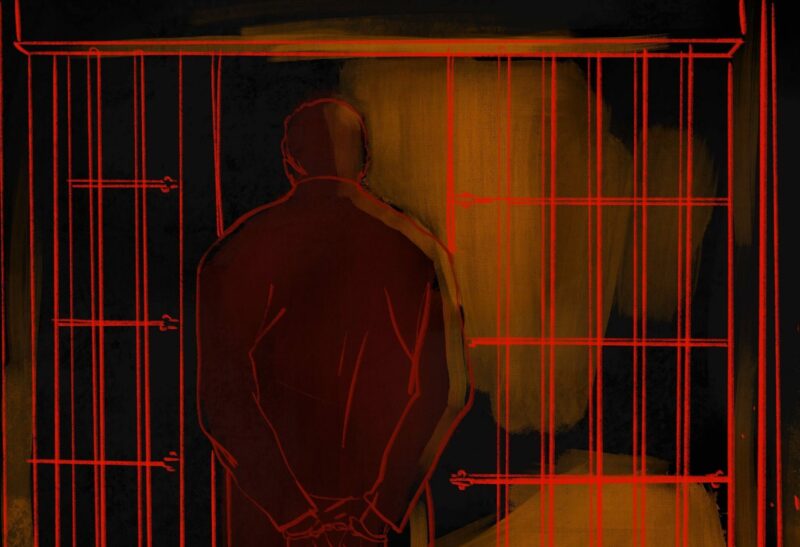Originally published by
iFact.ge
One of two rooms in Niyazi Safarov’s apartment is dangerous.
“After one year, cracks opened in the walls. We complained to the chief architect of the region. He came about three years ago and took photos, and told us money would be allocated for repair,” Safarov says.
“The cracks are getting bigger. Five times I appealed to the housing and operation offices. In the end they said that there is nothing they can do.”
So the Azerbaijani family of four lives in one room. The apartment, located in Banovshalar settlement, Aghdam region, was constructed in 2005 to house refugees and internally displaced persons (IDP) like Safarov.
Refugees in neighboring Dordyol settlement report some wall cracks so wide you can clearly see outside. They say any repair work is low quality, and there are no heating systems.
Aghdam region is located about 250 kilometers west of Baku, right on the front line where the battle over disputed territory with Armenia is nearly three decades old. Refugees who lived in tents in the villages of Barda and Yevlakh were relocated in 2005 to the new housing.
According to a 2017 report, Shams-95 was one of the construction companies that won tenders to construct refugee housing. Other include OJSC Azeragrartikinti, Alibeyli LLC and Khumar-98.
Shams-95 was registered on February 17, 1995. Founder-director Gasim Gasimov is the former deputy head of the Aghdam region government. His brother Lufti Gasimov is the Aghdam region chairman for the ruling New Azerbaijan Party.
Shams-95 also receives numerous contracts to construct schools and government buildings all over Azerbaijan.
Much of the money comes from the Heydar Aliyev Foundation, named for the former president and father of current president Ilham Aliyev. The foundation is headed by current First Lady Mehriban Aliyeva. Ilham Aliyev, has attended at least 13 opening ceremonies for Gasimov projects.
According to the Azerbaijan government, there are 1.025 million refugees and IDPs out of a total population of a little over 9 million. (Government estimates on the number of refugees vary by as much as 100,000.) They include people who lived in Armenia before fighting broke out in 1988, and about 70,000 Meskhetian Turks who were originally deported from Georgia to Central Asia, and began arriving in Azerbaijan in 1989.
Since 1993, 6.2 billion manat ($3.65 billion in 2018 currency) have been allocated for refugee social problems. 2.8 billion manat came from the Azerbaijani government, 2 billion from the country’s Oil Fund, and 1.4 billion from international financial and humanitarian donor organizations.
A national aid program started in 2004 for those affected by the Nagorno-Karabakh disputed territory battles paid for food, utilities and some other expenses.
But those allowances were cancelled in 2017 and replaced by a monthly payment of only 20-36 manat ($12-21) per person. On March 1, 2018, a decree by President Ilham Aliyev increased the monthly payment by 10 percent.
A 2012 report by the Chamber of Accounts (the country’s chief auditing organization) admits: “the exact lists of (refugee) consumers and the amount of utility payments (given to them) are not correctly calculated. In some regions there are more refugees listed than exist. Some people are registered in several districts at the same time.”
The report goes on to say there were at least 22 cases where utility companies were paid too much for the electricity they supplied to refugees.
2.3 billion manat ($1.35 billion) has been spent on refugee construction since 2010, but iFact.ge could find only 122 million manat in public records.
In the past 14 years, the Oil Fund revenues have created housing for only 250,000 refugees. Apartments paid for by the Oil Fund on average cost 63,800 manat ($37,500) to construct, compared to only 16,040 manat ($9,400) for apartments paid for by other donors.
A special tender commission was set up in 2004 for refugee construction, but a 2015 Chamber of Accounts report said the commission isn’t actually operating.
Another company that participated in refugee construction is AS Group Investment. The company belongs to Shahin Movsumov, whose brother is Oil Fund executive director Shahmar Movsumov.
AS Group Investment received one no-tender contract for 4.7 million manat ($1.9 million) for two apartment buildings with a total of 36 units in the Tartar region. It’s part of a huge project to house 1,170 families in 30 buildings.
According to a government website, AS Group Investment has built refugee housing in at least 10 districts.
According to the National Committee for Refugee Affairs, a total of 97 buildings have been constructed. Deputy Prime Minister Ali Hasanov has been in charge of refugee affairs since 1988. He is also the chairman of the commission on International Humanitarian Aid, and supervisory board chairman of the Social Development Fund for IDPs.
His brother Ramiz Hasanov is the head of the Zangilan regional government in southwestern Azerbaijan. Since all of Zangilan is classified as being in occupied territory, the entire current population of 42,700 are classified as IDPs. (About 39,000 fled the region when fighting broke out in 1993).
Sixteen companies listed in tender information for Zangilan region all list Fakhraddin Mammadov as a founder. Mammadov companies won tenders in 2015 and 2017. But now he appears on a recent Azerbaijan travel ban list due to unpaid taxes.
Home is Inside Factory
A government program promised to improve housing, education and medical care for refugees by 2016. But in a phone interview, national refugee committee spokesman Elchin Gadimov said 340,000 refugees live in abandoned schools, kindergartens, hospitals and unfinished buildings.
There are approximately 160 refugee families living in an electrical parts factory on Ahmad Rajabli street in Baku.
Alagha Ismayilov is a refugee from Chaybali village, Aghdam region. He says his family moved into the factory in 1993.
“We have lost our health (while living) in the plant, and nobody has examined us,” he said. “We can’t stand the machine noise, the dust, the toxic chemical smoke. All the kids are often sick or poisoned. I try to take them out of here during the working day.
“We’ve appealed to the refugee committee for help, but nothing has changed. Every year they promise we will be moved to new apartments, but it never happens.”
Khatai Aliyev, 29, a refugee from Fuzuli region, lives in the same factory. He has trouble walking. “Everyone says there is free health care, but the doctors won’t take you (without payment),” he said. “I have no money for hospital treatment.”
Phantom Projects
iFact.ge found two small towns for which projects are listed, but there is no information where money was actually spent. Binagadi Ganjlar and Garant are both located in Mehdiabad settlement, Absheron region. Their populations have been slowly relocating into partially finished buildings since 2012.
There are no hospitals, food markets or schools.
According to a Garant school principal, there are eight building basements being used as “schools” with about 1,400 students. A real school is supposed to open in 2018. There are no plans for a kindergarten or a hospital.
Resident Zakir Hasanov points out there is no decent road to Baku, only 20 kilometers away. “When it rains, we get stuck in the mud,” he says. “If you call an ambulance when it is raining, it doesn’t come.”
Refugee construction in Binagadi Ganjlar and Garant was awarded to Darhal LLC and Gulf Group. Elshan Jabrayilov, whose brother Rafail Jabrayilov is a parliamentarian, is the listed owner for Darhal.
Some refugees from these two towns want to move back to Baku rather than live in unfinished buildings, kindergartens, schools and other public buildings.
At a 2017 event attended by First Lady Mehriban Aliyeva, the Department of Housing and Communal Services showed 50 apartments they provided to refugees. In their report of the event, state news agency Azertag wrote about the relocation of 2,181 refugee families and stated there were eight schools in the area.
There are no school buildings in the area.



